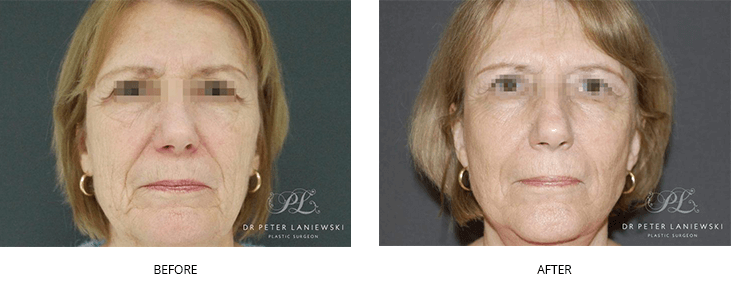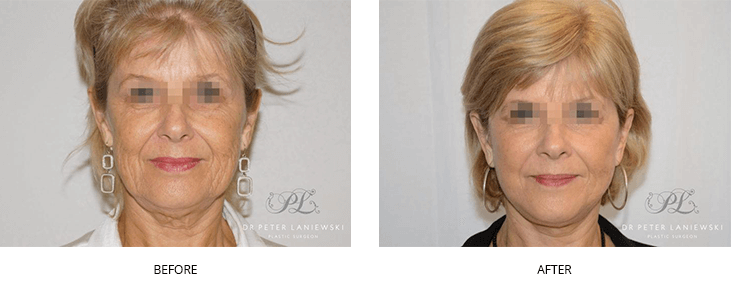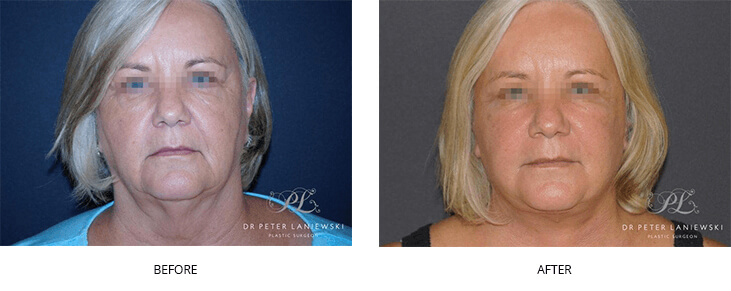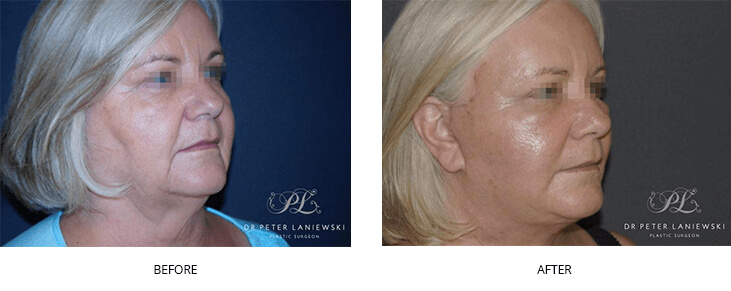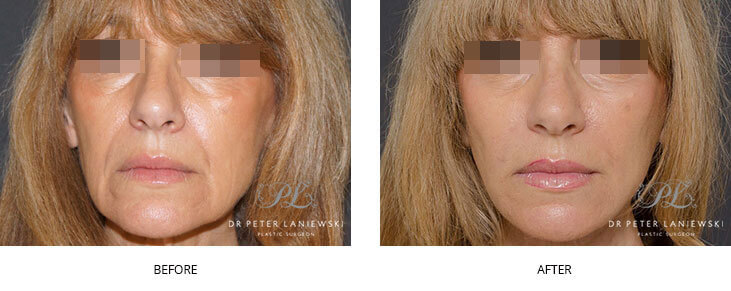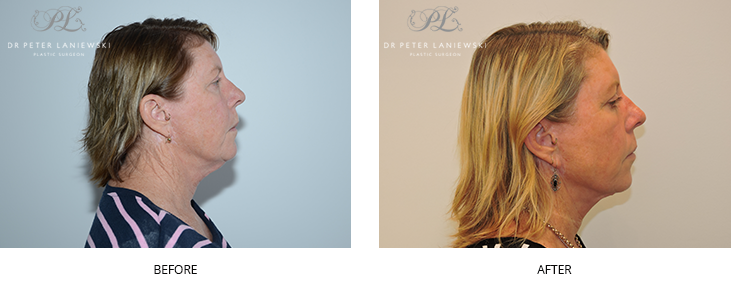A Meloplasty (facelift) can produce dramatic results, and new innovative techniques and procedures have revolutionised this surgical procedure. Reluctance toward undergoing a facelift due to fear of acquiring a frozen appearance has led to development of modern progressive techniques.
A facelift is designed to reduce the appearance of age-induced facial changes. Areas in the face and neck treated include:
- Skin around the middle of the face
- Volume loss to replenish facial contours
- Deep creases around the eyelids, mouth and nose
- Prominent jowls in the lower face
- Loose skin, prominent platysmal bands, skin or fatty deposits under the chin
A facelift is suitable for healthy individuals who don’t have underlying medical conditions that could impede healing. A positive outlook and realistic expectations are also essential.
Facelift – Dr Peter Laniewski
THE CONSULTATION
The initial consultation with Dr Laniewski will include a comprehensive discussion in terms of evaluating the areas of your face and neck you want to change. Facial features and skin characteristics will be evaluated, including rhytids (wrinkles), skin texture, folds and skin elasticity. Placement of any incisions will be in the hairline, and the overall bone and soft tissue structures of your face will determine the best surgical plan.
During your consultation, Dr Laniewski will also need to go through your medical history and find out more about what you expect to achieve by undergoing a facelift. You will also need to decide whether the facelift should be paired with a neck lift to achieve a more uniform result. You will be given time to think about the surgery before it is scheduled. This will occur after your second surgery consultation.
What are the different types of Rhytidectomies (facelifts) that are available?
There are three main types of facelifts that can be performed to address different signs of ageing.
- Mini rhytidectomy (facelift)-This technique focuses on the lower face and addresses jowls and general skin sagging.
- Mid Rhytidectomy (Mid-facelift)-As the name suggests, a mid-facelift targets the middle of the face. Sagging skin and deep creases are reduced when this technique is used.
- Deep plane or composite facelift-This technique produces the most dramatic results and is ideal for high levels of cheek and neck sagging.
A facelift will not address lines across your forehead or around or the eye area blepharoplasty ( Eyelid surgery) and browplasty( brow lift) are required to achieve this result. If volume loss is also a concern, patients may wish to consider procedures such as fat grafting, facial implants or dermal fillers.
HOW IS A FACE LIFT PERFORMED
A facelift often combines the repositioning of deep tissue along with the removal of unwanted skin and fat. This multi-layered approach can provide results that comprehensively reduce the age-induced changes to your facial appearance. Autologous fat transfer may also be performed as part of the procedure.
There are a lot of variations to facelift procedures depending on individual requirements and underlying conditions. Most commonly, a facelift involves the surgeon creating an incision that is hidden in the hairline and around the natural contour of the ears.
Skin is freed from underlying tissues for a very short distance of 3cm to allow access to the deep plane before being repositioned up and back. Excess skin is then removed and the skin sutured back together without tension. A deep plane face lift elevates the skin, fat and SMAS layer as a single or composite unit. This technique results in less bruising and swelling than a traditional SMAS facelift. The result a natural and anatomical. The incisions are concealed and precise, resulting in an undamaged facial appearance. Generally, the stitches are placed under the skin and will dissolve organically.
The surgery takes several hours and depending on the work performed you may elect to a night in hospital before returning home.
CAN I COMBINE MY RHYTIDECTOMY(FACE LIFT) WITH A BROWPLASTY( BROW LIFT)?
Yes, it is common for patients to combine a facelift with additional procedures to achieve a more uniform appearance. Some of the most common procedures include a brow lift, eyelid surgery and a neck lift (Platymsaplasty).
WHEN CAN I RETURN TO MY NORMAL ROUTINE
Patients will need to be at home for a week or two after a facelift. In terms of resuming your normal routine, which includes exercise, it is best to wait at least six weeks. Engaging in activities that could place additional pressure on the face before you are fully healed can impact the final results of your surgery. In most instances, patients will only feel more like themselves again after a few months, so patience will be necessary. Recovery is different for every patient.
Post operative LED Light Therapy is strongly recommended to decrease your downtime and speed healing immediately after your surgery. The treatment is convenient and can be combined with your post operative visits. Lasting only thirteen minutes and completely painless, LED Light Therapy is clinically proven (in peer reviewed scientific publications) to dramatically reduce the swelling and bruising that can occur after your surgery and to minimise visible post-operative scarring. Please speak to our specialist surgeon Dr Peter Laniewski or one of his consultants to book in your treatment.
HOW MUCH DOES A RHYTIDECTOMY ( FACELIFT )COST IN SYDNEY?
The final cost of a facelift depends on several different factors, including anaesthetic, surgeon and hospital fees, as well as the type of facelift that’s performed. Whether or not you combine a facelift with a neck lift or any other anti-ageing surgery will also alter the final cost of the surgery. Overall, the more work that needs to be done, the higher the cost of the surgery. Since this is a purely cosmetic procedure, it won’t be covered by health insurance. You can obtain a more accurate quotation by scheduling a consultation with Dr Laniewski who will take your specific requirements into consideration.

